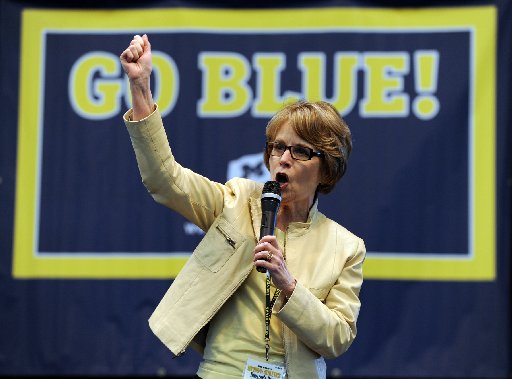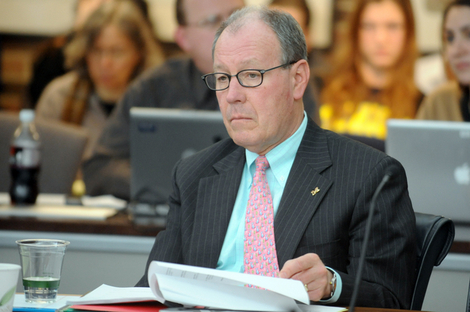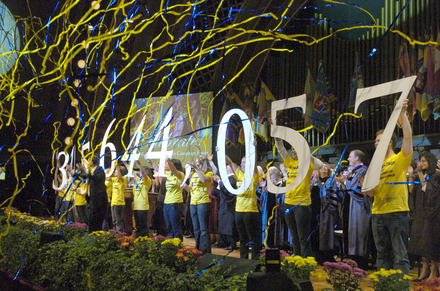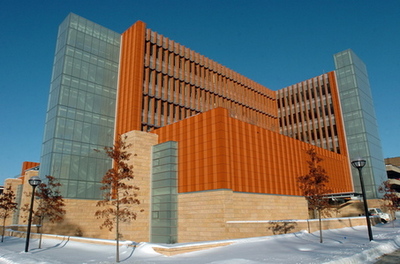University of Michigan gearing up to launch multibillion fundraising campaign next fall

"All of us agree that this next campaign will have very aggressive goals for student aid," U-M President Mary Sue Coleman said of the school's next capital fundraising drive, which is expected to launch late next fall.
Lon Horwedel | AnnArbor.com
The University of Michigan is poised to launch its next multibillion dollar fundraising campaign late next fall.
This year officials —from assistant professors and student affairs staff to deans and top executives— are gearing up for the campaign, helping administrators clearly define goals and working to form relationship with wealthy prospects.
Although university officials say they haven't set a campaign goal yet, the fundraising target will likely surpass the $3.2 billion raised during the four-year Michigan Difference campaign, which surpassed the original $2.5 billion goal. That drive ended in 2008, right before the financial crisis struck.
The forthcoming campaign will likely last between five and seven years. Its focus will be distinct from the Michigan Difference, with an eye toward people and scholarships and less on buildings (there were 22 building projects in the last campaign).
It will also celebrate a unique milestone: The university's bicentennial.
"Big campaigns like this take a lot of planning because you want to make sure you've aligned your goals and you've got everybody participating and contributing on how the campaign is going to be shaped," U-M President Mary Sue Coleman, who led the Michigan Difference campaign, said in an interview. "Thousands of people across the university build it layer by layer."
Gift giving to U-M has averaged $272 million annually over the last three years. During fiscal 2012 U-M brought in $288 million in gifts, compared to the $342 raised in 2008, the final year of the Michigan Difference campaign.

Jerry May, U-M's chief fundraiser, will be in charge of managing the university's next capital campaign.
Melanie Maxwell | AnnArbor.com
Jerry May, U-M's chief fundraiser and vice president for development, said campaigns increase annual giving by roughly 40 percent.
"It ratchets up because of the intensity of the campaign, because of the focus the developments have. And we ask donors to give larger gifts," May said.
Elite public universities, on average, receive less donations than elite private universities.
For example, the top fundraiser among private universities in 2011 was Stanford, which raised $709 million. That year the top public fundraiser, the University of California at Los Angeles, raised $415 million— Both universities were in the midst of fundraising campaigns and are located in the same state.
Yet donor support is vital for public schools in an era of decreasing state appropriations.
"The great public universities of the U.S. are the ones that, 20, 30 or 40 years ago, were foresighted enough to say state support is going down, we've got to start raising money because otherwise we could have the potential to become a mediocre institution," said May, adding that the university is on target to launch its next campaign in late fall of 2013.
Determining goals
Choosing a focus and a fundraising goal is a delicate undertaking.
The focus must resonate with donors and the goal has to be achievable, yet a stretch from the ordinary. Surpassing fundraising goals within a set campaign time, as U-M did in 2008, is rare. Many other schools, such as Cornell University, Columbia University and the University of Virginia, have needed to extend campaign end-dates in order to achieve goals.
The goals also make a statement about the university. Stanford, for example, completed the largest fundraising drive in higher education history in 2011, at $6.2 billion, nearly $2 billion more than the school's original goal. To date, Stanford's haul hasn't been matched and the school remains the envy of its peers in the fundraising arena.
The University of Virginia, on the other had, struggled mightily to meet the $3 billion fundraising goal it set in a campaign launched in 2004. The campaign was $400 million short of its target at the end of 2011, when it was scheduled to close. The university extended the drive, but the unmet goal was a high-profile miss.

University of Michigan students hold up numbers at Hill Auditorium in November 2008 to represent the $3.1 billion raised during The Michigan Difference. A month later, when the campaign officially closed, U-M had brought the total raised to $3.2 billion.
"There’s competition out there and like anybody in fundraising we’re competitive people," May said. Setting a goal, he added, isn't as simple as determining a figure.
"If you don't start with what the need is and what you're trying to accomplish, then you're raising money for hollow reasons and donors know this," he continued. "You've got to have ideas first."
The ideas U-M is centering its upcoming campaign around include supporting global, real-world experiences for students, increasing scholarship support and funding for cross-collaboration between units. The school has also considered raising funds for a new cancer center (funds from the Michigan Difference campaign contributed to the new $754 million C.S. Mott Children's Hospital & Von Voigtlander Women's Hospital that opened in 2011).
The Michigan Difference earned $519 million for student support and Coleman said the upcoming campaign "will have to do better."
"All of us agree that this next campaign will have very aggressive goals for student aid," Coleman said.
Building blocks of a campaign
The success of a major capital campaign depends in part on a school's ability to attract large donors. For example, Stephen M. Ross donated $100 million to the business school during the Michigan Difference, leading to one of the most impressive buildings on the Ann Arbor campus.

University of Michigan's Ross School of Business is a byproduct of the Michigan Difference campaign.
File photo | AnnArbor.com
While the fruits of those relationships materialize during the campaign, they're the result of years of relationship building that begins before the campaign starts.
"He had this long-term relationship," May said of Ross. "[There was] lots of giving over a period of time."
Oftentimes a donor will give the university moderate sums of money before bestowing a large gift. This allows donors to test the stewardship of the university.
"There has to be a matching vision between the academic leader — often the dean or the president or both — and the donor," May explained. "In Steve's case, the former business dean, Bob Dolen, had a vision for the facilities and group study rooms.
It's a long process."
U-M has 40 annual gift officers and 175 officers and directors who handle major gifts above $100,000. The average tenure of a major gift officer is 7.8 years and the average tenure of a fundraiser that handles gifts of $2 million and above is 9.4 years.
According to U-M's salary database, the average salary for a major gift officer is $87,600.
As the school gears up for the campaign, it also begins to identify donors who will not only give financially, but who will be willing to lead the drive as well. For example, donors who commit to give more than $5 million are often given a title and asked to solicit their friends and host campaign events.
Penny W. Stamps, whose family recently awarded the School of Art and Design $32.5 million, chaired the Michigan Difference.
But not all donors are wealthy. Roughly 365,000 people contributed to the Michigan Difference, and the vast majority of them gave small gifts. In fact, one of the biggest successes of a campaign is the increase in annual giving universities often see after a campaign.
During a campaign annual givers may increase their yearly pledge — say from $50 to $100 — and not reduce it when the drive is over. Thus the campaign increases the threshold for thousands of donors.
"You stay at that level until the next big ask," explained Judith Malcom, director of executive communications for U-M Development.
Kellie Woodhouse covers higher education for AnnArbor.com. Reach her at kelliewoodhouse@annarbor.com or 734-623-4602 and follow her on twitter.


Comments
AMOC
Tue, Nov 13, 2012 : 1:52 p.m.
I am a UM alum and a Michigan taxpayer, and UM will never get a penny more from me than what I am required to pay in taxes while it continues to undermine state law and any institutional dedication to academic excellence by pursuing race-based admission preferences and the admission of major-sport atheletes who could not conceivably succeed at UM in an academic discipline without massive tutoring /preferences. I have no quarrel at all with a committment to equal opportunity for those equally prepared to take advantage of it. But admitting students whose preparation for college work is not commeasurate with the majority of their classmates leads to a disproportionate number of those ill-prepared "affirmative action" students flunking out or dropping out well before graduation. This will often saddle them with undischargeable student loan debt for the rest of their lives; no favor to a"deserving" minority student. Let students with an average academic record in HS attend an "average" college or community colleges for their first few years. One of the great things about the United States is that no one is permanently barred from educational opportunities or career-change options if they are willing and able to do the work.
CU Alum
Tue, Nov 13, 2012 : 12:50 a.m.
"Many other schools, such as Cornell University, Columbia University and the University of Virginia, have needed to extend campaign end-dates in order to achieve goals. " Not true, at least for Columbia. Its original campaign goal was $4 billion by December 2011, but the campaign was so successful that it was going to hit the target almost a year early. So in December 2010 the university raised the goal to $5 billion by December 2013. (See http://news.columbia.edu/oncampus/2248.) The end-date was extended, but not because Columbia needed more time to reach the original goal.
Arborcomment
Mon, Nov 12, 2012 : 11:28 p.m.
Cap non-residents attending M at 35% of the student body, and we'll talk about continuing my contribution. The "talk" will also include what serious cost cutting measures actually being done to lower tuition costs.
Lets Get Real
Mon, Nov 12, 2012 : 11:25 p.m.
Regrettably, for my dollar, Mary Sue Coleman's statement about "agressive donations for student aid" will need to be dedicated to American students. The changing face of the student population at Michigan is well documented and disappointing. If coming to Michigan is so desirable to foreign students, let their countries or their families support their education. I'm interested in American citizens becoming students at America's prestigious institutions to give them the opportunity to learn, grow and become contributing citizens. Far too many of our dollars have gone over seas and support far too many people who are not our citizens. Time to reighn in our spending and concentrate on our own. I decide where my money is spent, and without dedication guarantees, it will not be donated.
Kellie Woodhouse
Mon, Nov 12, 2012 : 6:53 p.m.
Here's a quote from Mary Sue Coleman on the building aspect of the Michigan Difference: "In the last campaign we had a lot of building needs. They had built up over time and we hadn't addressed them, so it was extremely important that we do work on the infrastructure because the places where students learn and where faculty work make a huge difference in our competitiveness and in our ability to provide the right kind of environment...." I wasn't able to fit it into the story, but it addresses some of the comments here so I thought I'd post. The quote came from a late October interview with Coleman. Kellie
macjont
Mon, Nov 12, 2012 : 4:25 p.m.
Since my 1967 graduation from U of M, the University has spent a great deal making its facilities for educating its students competitive with any university in the country --- with one exception. A campus tour will illustrate. Start on North Campus and note the latest and best to educate our engineers of the future. In 1967, the "Engine School" was located in a couple of buildings on Central Campus. Next note the U of M Hospital facilities, where we educate our future doctors. Though used for more than training doctors, it also is a tremendous enticement for those wishing to become doctors to come to U of M. Move to the U of M athletic campus. Has any university spent more to attract and train the best athletes the nation has to offer? Drive back up State Street to see the new School of Public Policy. U of M clearly wants to provide the best for our future policy makers. Next on State Street, we encounter the Law School, a facility very different from the one where I received my law degree in 1975. We want the best and the brightest to come to our law school and we provide them with the best when they get here. Turn a couple of corners and on Tappan we see the Ross School of Business. I believe that school has been made over twice since I was an undergrad, at what cost I do not know. Around the corner on East University next to the Business School, we find my conclusion: The University of Michigan School of Education. I received my teacher's certificate in 1967 by taking a few classes in that building, one that today remains little changed from 1967. For the "data driven" people out there (the numbers obsessed), I cannot provide precise information comparing the money we have spent on the Ed School with that spent on the other aforementioned institutions. I suspect, however, that for a society that professes to care about education, the numbers would be shocking. One can only hope that a U of M fundraising drive will meet this challenge.
macjont
Mon, Nov 12, 2012 : 6:28 p.m.
Also consider, Dcam: http://www.ox.ac.uk/about_the_university/foundations_for_the_future/index.html
macjont
Mon, Nov 12, 2012 : 6:20 p.m.
Something missing from your analysis, Dcam. Facilities do attract top flight students and faculty --- at least in this country. It may not be right, but it is reality. (I'll be looking for your positive rating.)
Dcam
Mon, Nov 12, 2012 : 5:53 p.m.
And then we take a tour of the Oxford campus and find 800 year-old facilities still turning out students, with thousands more begging to be allowed to join the ranks of the elite grads. Buildings don't make a college, but they often make for extremely high overhead.
MRunner73
Mon, Nov 12, 2012 : 3:53 p.m.
As a loyal and donating alumni, the "aggressive " fund raising campainge is as bad or worse than tellemarketers. I no longer accept their phone call asking for plegdes. I get the donation card in the mail then fill it out and donate when I feel ready and able. Given the other artcile in today's AA.com about the increasing foreign student population, I am less inclined to donate because I ask, what university am I supporting? Donate, I will be it will remain the same sum.
brimble
Mon, Nov 12, 2012 : 2:50 p.m.
For better or worse, and maybe the latter, universities have to find ways of being self-sustaining non-profit education corporations. @Kronoberger has it right, though. Lots of money makes it ever easier to lose focus and forget the core mission of the institution, to lose the habit of pursuing value, to become fat and sassy rather than lean and hungry.
Kronoberger
Mon, Nov 12, 2012 : 1:51 p.m.
Billions more? To what ends and for whose benefit? Given the corporate model pursued by the U these oceans of dollars will most likely simply provide embellishment for what Thomas Merton called that "...noisy highway 0f pragmatism leading between banks of artificial flowers to gates of despair."
greg, too
Mon, Nov 12, 2012 : 2:53 p.m.
"To what ends and for whose benefit?" The schools and the students. If people want to give their money as a tax write off so their alma mater can have shiny buildings, let me. I would prefer they would give the money to a charity doing some good, but it's their money... "Lots of money makes it ever easier to lose focus and forget the core mission of the institution" In modern education, the president's main job at a major university is to raise the endowment and build shiny things. She seems to be pretty good at it. And it beats the alternative of old nasty buildings and less stuff.